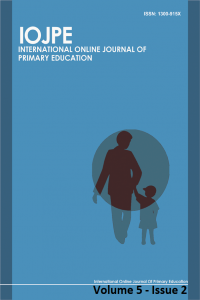Abstract
Desk arrangements in primary classrooms can encourage or negatively influence learning. With no previous research reporting on student perspectives, we explored perceptions of two common desk configurations (Year 3, n=32, mean age=8 years). Qualitative data were collected by means of open-ended questionnaire, with an even spread of most preferred desk arrangements (n=16 Clusters, and n=14 Traditional Rows. Clusters were preferred for “increased interaction with friends”, clearer view of the board” and “ease of movement/easier to get out of my seat”. The reasons given for preferring Traditional Rows were “minimisation of peer distractions”, “familiarity”, “clearer view of board”, and “can hear the teacher”. Researcher observations were also undertaken during ten normal handwriting lessons (5 observations with Traditional Row configurations in place, and 5 observations during Cluster configurations). We observed fewer off–task behaviours during lessons held with Cluster desk configurations. Students tended to turn around more during lessons with the Traditional Row desk formation in place during completion of an individual task. Future research is needed to illuminate the impact of desk configurations incorporating a greater range of desk formations, larger sample sizes, varying socio-economic groupings, open–plan versus conventional classroom spaces and comparison of diverse technologies, student groups and lessons.
References
- Adams, D. 2009.“The impact of seating arrangement upon a discussion-based, secondary social studies classroom.” In Culminating Experience Action Research Projects, edited by Deborah A. McAllister and Cortney L. Cutcher, 14: 5–24. Chattanooga, TN: College of Health, Education, and Professional Studies, The University of Tennessee.
- Balli, Sandra J. 2009. Making a Difference in the Classroom: Strategies that Connect with Students. Lanham, MD: Rowman and Littlefield Education.
- Bonus, Michelle, andLinda Riordan. 1998. Increasing student on–task behaviour through the use of specific seating arrangements.(Master’s Thesis). Chicago, IL: Saint Xavier University. ERIC Document Reproduction Service No. ED42229.
- Callahan, Jessica. 2004. Effects of Different Seating Arrangements in Higher Education Computer Lab Classrooms on Student Learning, Teaching Style and Classroom Appraisal.(Master’s Thesis). Gainesville, FL: Graduate School, University of Florida. http://etd.fcla.edu/UF/UFE0005320/callahan_j.pdf.
- Currie, Janet. 2014. Teaching Health and Physical Education in the Secondary School. Camberwell, Victoria: ACER Press.
- Denscombe, Martyn. 2007. The Good Research Guide for Small-Scale Social Research Projects. Berkshire, England: Open University Press.
- Guardino, Caroline A., and Elizabeth Fullerton. 2010. “Changing Behaviors by Changing the Classroom Environment”.TEACHING Exceptional Children 42(6): 8–13.
- Hastings, Nigel, and J. Schwieso. 1995. “Tasks and Tables: The Effects of Seating Arrangements on Task Engagement in Primary Classrooms.”Educational Research37(3): 279–291.
- Hood–Smith, N.E., and R.J. Leffingwell. 1983. “The Impact of Physical Space Alternation on Disruptive Classroom Behavior: A Case Study.” Education104: 224–231.
- Kelley, W. Michael. 2016. “Rookie Teaching Technique: Choosing a Seating Arrangement.” For Dummies. Making Everything Easier. Accessed March 7, 2016 http://www.dummies.com/how-to/content/rookie-teaching-technique-choosing-a-seating-arran.html.
- Lotfy, Nohayer. 2012. Seating Arrangement and Cooperative Learning Activities: Students’ On–Task/Off–Task Participation in EFL Classrooms.(Master’s Thesis). Cairo, Egypt: The Department of Teaching English as a Foreign Language (TEFL), The American University in Cairo.
- Lane, Kathleen Lynne, Holly Mariah Menzies, Allison L. Bruhn, and Mary Crnobori. 2010. Managing Challenging Behaviours in Schools: Research-based Strategies that Work.NY: The Guildford Press.
- Moore, D.W., and T. Glynn. 1984. “Variation in question rate as a function of position in the classroom.” Educational Psychology 4: 233–248.
- Savage, Tom V., and Martha Kent Savage. 2010. Successful Classroom Management and Discipline: Teaching Self-Control and Responsibility. Thousand Oaks, CA: SAGE Publications.
- Strauss, Anselm, and Jane Corbin. 1990Basics of Qualitative Research.Newbury Park, CA: Sage.
- Unger, Melanie S.2011.Organized Teacher, Happy Classroom: A Lesson Plan for Managing Your Time, Space and Materials. London: F&W Media, Inc.
- Wheldall, K., andY.Y. Lam. 1987. “Rows Versus Tables: The Effects of Two Classroom Seating Arrangements on Classroom Disruption Rate, On-task Behaviour and Teacher Behaviour in Three Special School Classes.” Educational Psychology: An International Journal of Experimental Educational Psychology 7(4): 303–312.
- Wright, D. (1998). Managing Behaviour in the Classroom: Practical Solutions for Everyday Problems. UK: Heinemann Educational Publishers.
Details
| Primary Language | English |
|---|---|
| Subjects | Other Fields of Education |
| Journal Section | Research Articles |
| Authors | |
| Publication Date | December 31, 2016 |
| Published in Issue | Year 2016 Volume: 5 Issue: 2 |
Creative Commons Licenses

All articles published in International Online Journal of Primary Education's content is licensed under a Creative Commons Attribution 4.0 International License (CC BY 4.0).
(Counter start: February 28, 2021)




